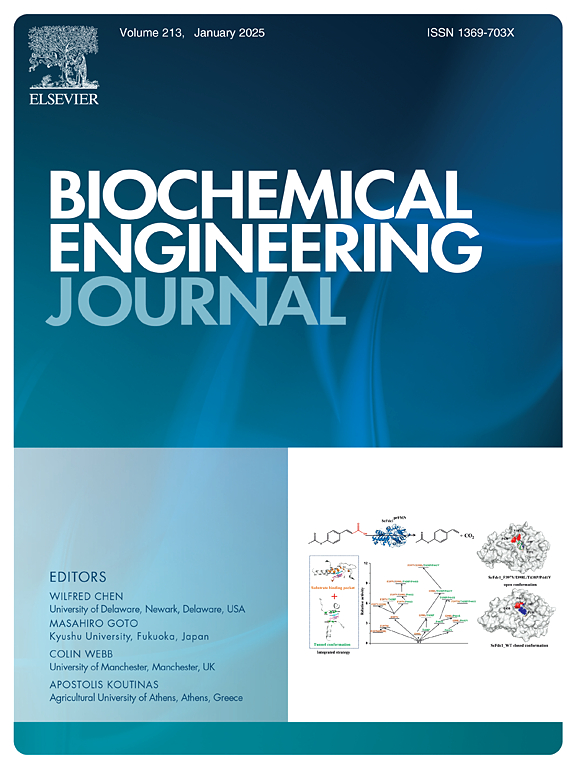Enhanced nitrogen removal through rapid biofilm formation by Paracoccus sp. XN-1 immobilized carriers in sequencing batch biofilm reactor
IF 3.7
3区 生物学
Q2 BIOTECHNOLOGY & APPLIED MICROBIOLOGY
引用次数: 0
Abstract
Biofilm formation is critical for wastewater treatment efficiency, but slow biofilm development often limits system startup and performance. In this study, a sequencing batch biofilm reactor (SBBR) was established to evaluate Paracoccus sp. XN-1's capability to accelerate biofilm formation for treating aquaculture wastewater. Results showed that XN-1 inoculation (T-SBR) significantly enhanced biofilm formation, achieving mature biofilm development within 36 days compared to 48 days in conventional activated sludge (SBR). This rapid startup is particularly valuable for aquaculture facilities that require efficient and stable wastewater treatment systems to maintain water quality during intensive farming. High-throughput sequencing revealed distinct microbial community structures between the two systems, with T-SBR showing enrichment of key functional groups, particularly Methyloparacoccus (4.8 %) and Lysinibacillus (21.4 %). Network analysis demonstrated complex ecological interactions within T-SBR, with Methyloparacoccus forming a central hub coordinating nitrogen transformation processes. Functional prediction indicated enhanced nitrogen metabolism and oxidative phosphorylation pathways in T-SBR, contributing to superior NH4+-N (99.27 %) and TN (83.14 %) removal efficiencies. These results demonstrate that XN-1 inoculation optimizes microbial community assembly for enhanced nitrogen removal, providing a practical solution for sustainable aquaculture wastewater treatment.
副球菌sp. XN-1固定化载体在序批式生物膜反应器中快速形成生物膜增强脱氮
生物膜的形成对污水处理效率至关重要,但生物膜发育缓慢往往限制了系统的启动和性能。本研究采用测序间歇式生物膜反应器(SBBR)对副球菌sp. XN-1处理水产养殖废水加速生物膜形成的能力进行了评价。结果表明,XN-1接种(T-SBR)显著促进了生物膜的形成,与常规活性污泥(SBR)的48天相比,XN-1接种(T-SBR)在36天内实现了成熟的生物膜发育。这种快速启动对于需要高效和稳定的废水处理系统来维持集约化养殖期间水质的水产养殖设施尤其有价值。高通量测序揭示了两个系统之间不同的微生物群落结构,T-SBR显示出关键功能基团的富集,特别是甲基副球菌(4.8 %)和赖氨酸芽孢杆菌(21.4% %)。网络分析表明,T-SBR内部存在复杂的生态相互作用,甲基副球菌形成协调氮转化过程的中心枢纽。功能预测表明,T-SBR增强了氮代谢和氧化磷酸化途径,有助于提高NH4+-N(99.27 %)和TN(83.14 %)的去除效率。以上结果表明,接种XN-1可优化微生物群落组合,增强脱氮能力,为水产养殖废水的可持续处理提供切实可行的解决方案。
本文章由计算机程序翻译,如有差异,请以英文原文为准。
求助全文
约1分钟内获得全文
求助全文
来源期刊

Biochemical Engineering Journal
工程技术-工程:化工
CiteScore
7.10
自引率
5.10%
发文量
380
审稿时长
34 days
期刊介绍:
The Biochemical Engineering Journal aims to promote progress in the crucial chemical engineering aspects of the development of biological processes associated with everything from raw materials preparation to product recovery relevant to industries as diverse as medical/healthcare, industrial biotechnology, and environmental biotechnology.
The Journal welcomes full length original research papers, short communications, and review papers* in the following research fields:
Biocatalysis (enzyme or microbial) and biotransformations, including immobilized biocatalyst preparation and kinetics
Biosensors and Biodevices including biofabrication and novel fuel cell development
Bioseparations including scale-up and protein refolding/renaturation
Environmental Bioengineering including bioconversion, bioremediation, and microbial fuel cells
Bioreactor Systems including characterization, optimization and scale-up
Bioresources and Biorefinery Engineering including biomass conversion, biofuels, bioenergy, and optimization
Industrial Biotechnology including specialty chemicals, platform chemicals and neutraceuticals
Biomaterials and Tissue Engineering including bioartificial organs, cell encapsulation, and controlled release
Cell Culture Engineering (plant, animal or insect cells) including viral vectors, monoclonal antibodies, recombinant proteins, vaccines, and secondary metabolites
Cell Therapies and Stem Cells including pluripotent, mesenchymal and hematopoietic stem cells; immunotherapies; tissue-specific differentiation; and cryopreservation
Metabolic Engineering, Systems and Synthetic Biology including OMICS, bioinformatics, in silico biology, and metabolic flux analysis
Protein Engineering including enzyme engineering and directed evolution.
 求助内容:
求助内容: 应助结果提醒方式:
应助结果提醒方式:


